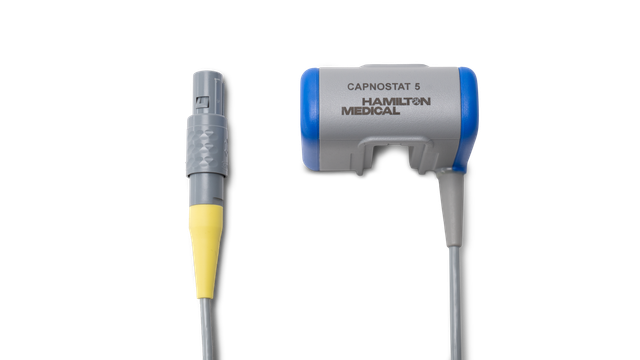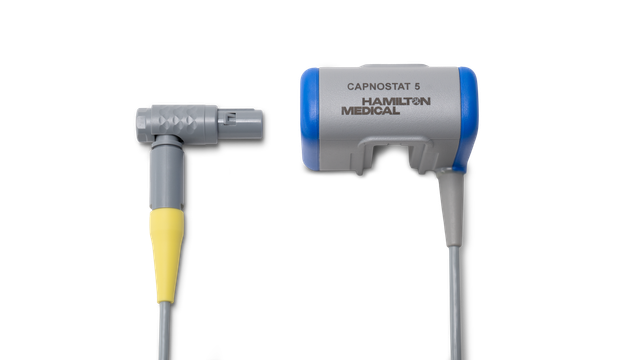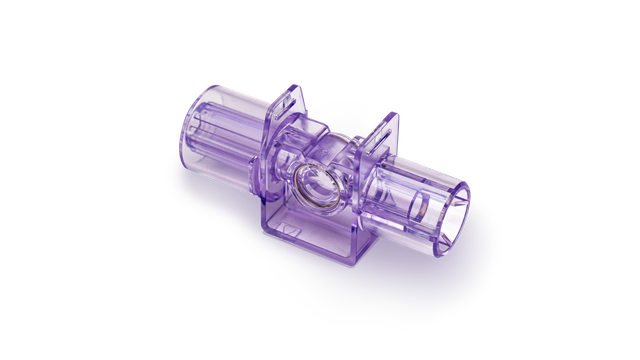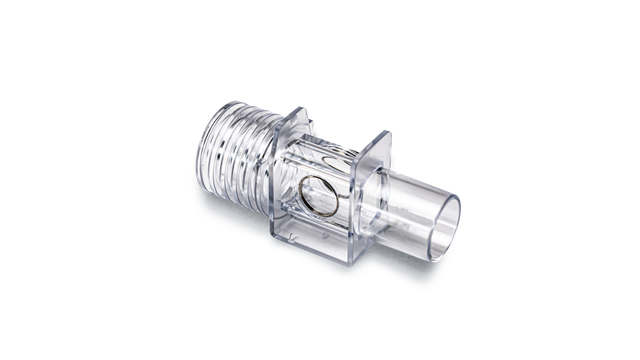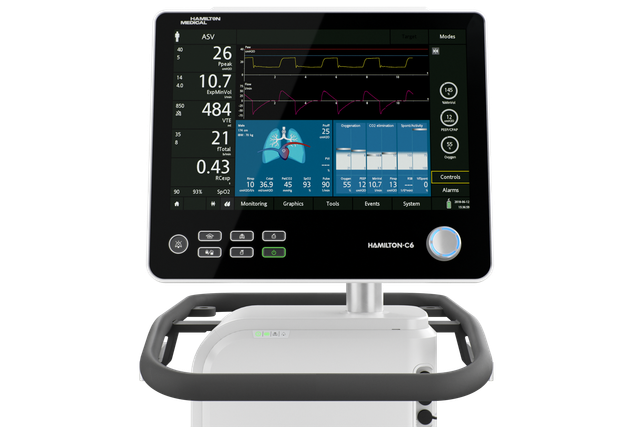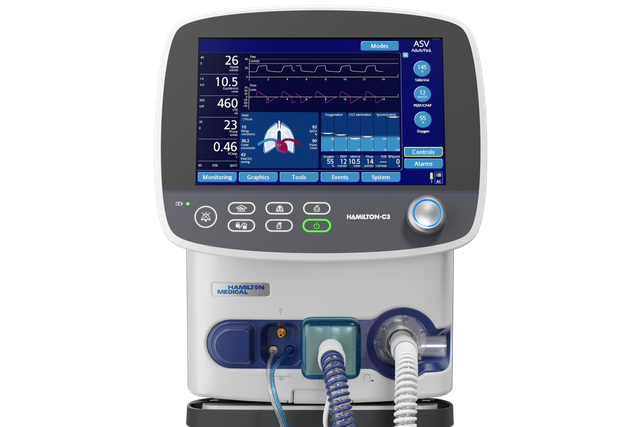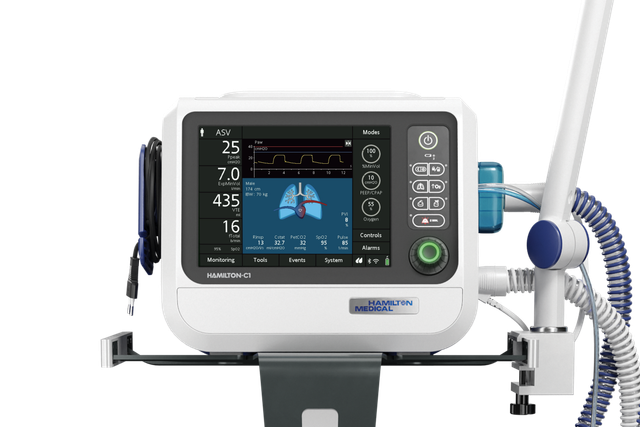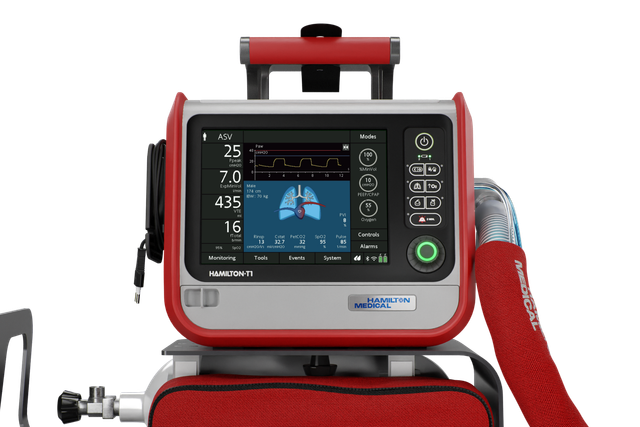
有关更多见解。 容积 CO2 监测
容积二氧化碳图的时相、形状和曲线形态和计算衍生的测量可以告诉您下列重要信息:
- 通气‑灌注效率
- 生理死腔比
- 病人的代谢率 (
Jaffe MB.Using the features of the time and volumetric capnogram for classification and prediction.J Clin Monit Comput.2017;31(1):19‑41. doi:10.1007/s10877‑016‑9830‑z1 )
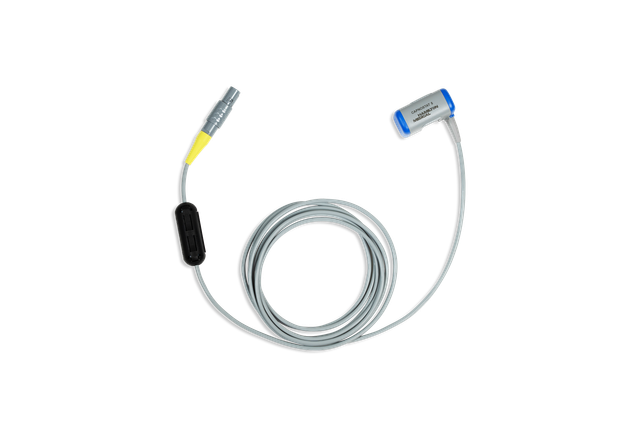
一个强大的工具。 CO2 传感器
在我们的呼吸机上,使用病人气道近端的 CAPNOSTAT‑5 主流式 CO2 传感器测量 CO2。
CAPNOSTAT‑5 传感器针对呼气末二氧化碳分压 (PetCO2) 以及在 150 次/分钟下所有呼吸频率的清晰、准确的二氧化碳图提供准确的测量。
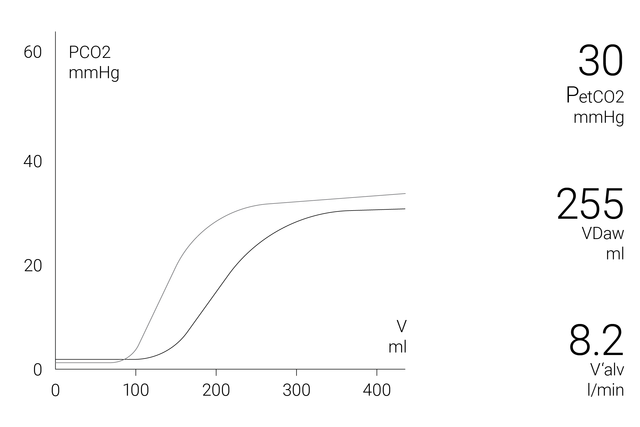
小传感器,大数据。 这就是您得到的数据
显示屏上的容积二氧化碳图窗口显示准确的定量信息作为近端流量和近端 CO2 数据的结合,例如:
- 当前容积二氧化碳图曲线
- 容积二氧化碳图参考曲线
- 带有参考环时间和日期的参考曲线按钮
- 每次呼吸的最相关 CO2 值
为了解更多关于病人状况的综合分析,可获得以下参数的 72 小时趋势图(或 HAMILTON‑S1/G5 呼吸机的 96 小时趋势图):
- PetCO2
- V‘CO2
- FetCO2
- VeCO2
- ViCO2
- Vtalv
- V'alv
- VDaw
- VD/Vt
- VDaw/VTE
- Slope CO2
为了使您一目了然,Hamilton Medical 哈美顿医疗公司呼吸机在二氧化碳监测窗口提供了所有 CO2 相关性数据的概览。
- 呼气末二氧化碳浓度:FetCO2 (%)
- 呼气末二氧化碳压力:PetCO2 (mmHg)
- 在“PetCO2”曲线中的肺泡平台的斜率,表示肺的容量/流量状态:slopeCO2 (%CO2/l)
- 肺泡潮气量:Vtalv (ml)
- 肺泡分钟通气量:V’alv (l/min)
- CO2 清除状态:V’CO2 (ml/min)
- 气道死腔:VDaw (ml)
- 气道开口处的气道死腔比:VDaw/VTE (%)
- 呼出的二氧化碳容量:VeCO2 (ml)
- 吸入的二氧化碳容量:ViCO2 (ml)
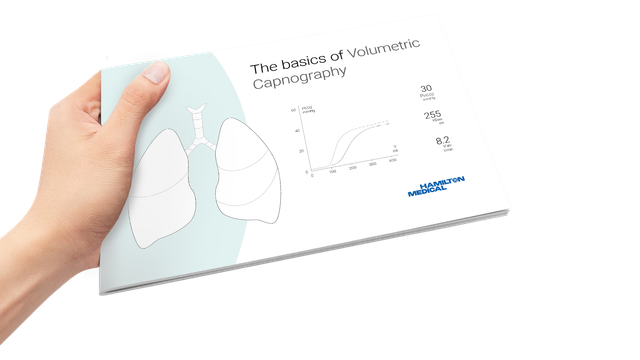
免费电子书
不可不知! 容积二氧化碳图的详情
学习如何解读容积二氧化碳图及了解容积二氧化碳图的优点和临床应用。包括自测内容!
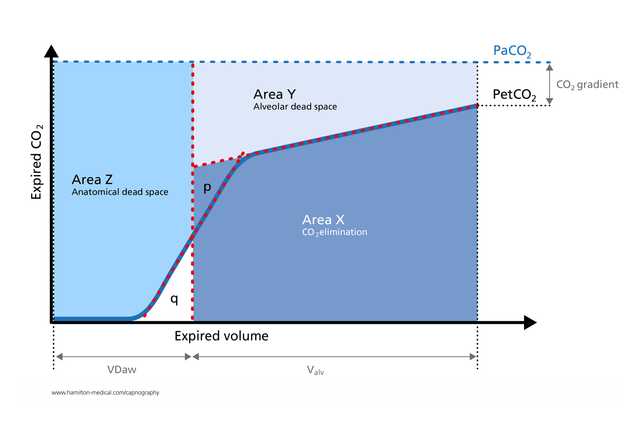
有哪些获益? 了解证据
容积二氧化碳图已成功用于测量解剖死腔、肺毛细血管灌注和通气效率 (
Romero PV, Lucangelo U, Lopez Aguilar J, Fernandez R, Blanch L. Physiologically based indices of volumetric capnography in patients receiving mechanical ventilation.Eur Respir J. 1997;10(6):1309‑1315. doi:10.1183/09031936.97.100613092 )容积二氧化碳图衍生计算有助于在床头识别肺动脉栓塞 (
Blanch L, Romero PV, Lucangelo U. Volumetric capnography in the mechanically ventilated patient.Minerva Anestesiol.2006;72(6):577‑585.3 )接受机械通气的 ARDS 病人生理死腔‑潮气量比的容积二氧化碳图测量与通过代谢监测技术获得的数据一样准确 (
Kallet RH, Daniel BM, Garcia O, Matthay MA.Accuracy of physiologic dead space measurements in patients with acute respiratory distress syndrome using volumetric capnography: comparison with the metabolic monitor method.Respir Care.2005;50(4):462-467.4 )呼气二氧化碳图是一种独立于呼吸努力、快速的无创测量,可帮助检测成人哮喘病人的显著支气管痉挛 (
Yaron M, Padyk P, Hutsinpiller M, Cairns CB.Utility of the expiratory capnogram in the assessment of bronchospasm.Ann Emerg Med.1996;28(4):403‑407. doi:10.1016/s0196‑0644(96)70005‑75 )容积二氧化碳图以无创、实时方式提供有关肺塌陷和肺复张生理学的宝贵见解,并有助于在床头监测周期性肺复张操作 (
Tusman G, Suarez‑Sipmann F, Böhm SH, et al.Monitoring dead space during recruitment and PEEP titration in an experimental model.Intensive Care Med.2006;32(11):1863‑1871. doi:10.1007/s00134‑006‑0371‑76 )

不可不知! 容积二氧化碳图培训资源
附件和耗材
我们提供成人、儿童和新生儿病人用原装耗材。您可根据您的机构政策选择可重复使用和一次性使用产品。
可用性
容积二氧化碳图可作为 HAMILTON‑C6、HAMILTON‑G5、HAMILTON‑C3 和 HAMILTON‑C1/T1 呼吸机的选配功能以及 HAMILTON‑S1 呼吸机的标准功能提供。
参考文献
- 1. Jaffe MB. Using the features of the time and volumetric capnogram for classification and prediction. J Clin Monit Comput. 2017;31(1):19‑41. doi:10.1007/s10877‑016‑9830‑z
- 2. Romero PV, Lucangelo U, Lopez Aguilar J, Fernandez R, Blanch L. Physiologically based indices of volumetric capnography in patients receiving mechanical ventilation. Eur Respir J. 1997;10(6):1309‑1315. doi:10.1183/09031936.97.10061309
- 3. Blanch L, Romero PV, Lucangelo U. Volumetric capnography in the mechanically ventilated patient. Minerva Anestesiol. 2006;72(6):577‑585.
- 4. Kallet RH, Daniel BM, Garcia O, Matthay MA. Accuracy of physiologic dead space measurements in patients with acute respiratory distress syndrome using volumetric capnography: comparison with the metabolic monitor method. Respir Care. 2005;50(4):462‑467.
- 5. Yaron M, Padyk P, Hutsinpiller M, Cairns CB. Utility of the expiratory capnogram in the assessment of bronchospasm. Ann Emerg Med. 1996;28(4):403‑407. doi:10.1016/s0196‑0644(96)70005‑7
- 6. Tusman G, Suarez‑Sipmann F, Böhm SH, et al. Monitoring dead space during recruitment and PEEP titration in an experimental model. Intensive Care Med. 2006;32(11):1863‑1871. doi:10.1007/s00134‑006‑0371‑7


